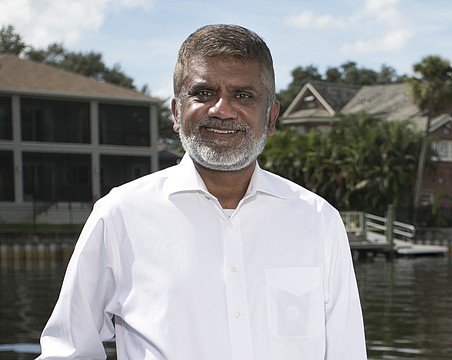Anything is Possible
By David R. Corder
Associate Editor
The legend of Chris-Craft began in 1874 when Christopher Columbus Smith built his first wooden duck-hunting boat in Algonic, Mich., at the age of 13. For decades, the company was considered the Mercedes of the boating industry - an American icon that attracted such clientele as John F. Kennedy, Franklin D. Roosevelt, Frank Sinatra and Elvis Presley.
But as icons often go, they don't last forever. In 2001, Chris-Craft's parent company filed for bankruptcy, and the operations at its Sarasota headquarters shut down.
Enter Stephen Julius and his partner, Stephen Heese, two investors who met as classmates at Harvard Business School. They had visions of returning the 131-year-old company to its position as the premier boat-builder in the country. The two, along with investor Clayton McNeel, purchased the company, mostly through their own personal finances from other turnarounds and investment situations, and gambled during a time when the market was facing a severe boat-buying downturn.
In the fall of 2001, shortly after 9/11, Julius, chairman of Chris-Craft, and Heese, president and CEO, watched nervously as they re-launched Chris-Craft at the Fort Lauderdale Boat Show.
"We invested all this money and all this time and were thinking, 'Is this industry going to be on its back for the next two years?' " Heese says.
Within five minutes of the opening of the boat show, a man wearing a fishing hat and fishing shirt walked by a new 28-foot Chris-Craft model in the showroom, did a double take, said a few words to his wife and whipped out his checkbook.
"At that point, we knew we knew we were off to the races," Heese says.
Under the new leadership, Chris-Craft Corp. has grown by 40% a year for the past four years. In 2004, the firm broke $50 million in revenue. At its annual dealer show two weeks ago in Sarasota, Chris-Craft signed 18 new dealers, bringing its total number of dealers to the 60s. Pre-bankruptcy, the firm had 80 dealers.
As Heese puts its, the hard part is over.
Now, the company is aiming to surpass $100 million in sales within the next five years. To reach that goal, Chris-Craft plans to release two new models annually for the next five years and increase its dealer presence worldwide.
"We're constantly focused on the next challenge rather than focus on short-term satisfaction," Heese says. "We believe our company can be $200 million to $300 million in size one day. I guess that's the ultimate dream, to continue to successfully develop new products, to continue to successfully expand the ranks of our distributors around the world. If we can continue to do those two things, I think we can be satisfied that we restored this company to its rightful place."
Says Julius: "The growth opportunity in the market is immense, and we don't intend to stop."
'Anything is possible'
In 2000, Heese, 44, joined his childhood pal, Clayton McNeel, in Tampa. Heese had just resigned as managing director of Erico International Corp., a construction products firm with operations in 16 countries. Heese had been living in Australia, where he sailed competitively for several years with a full-time crew on a boat dubbed "Anything is Possible."
Julius, 45, shared a similar passion for boats. An Anglo-Italian financier, Julius bought an Italian Division A soccer club, Vicenza, in 1997. He had a knack for turning around companies. He is managing director of Stellican Ltd., the London-based investment firm that purchased Chris-Craft in 2001 and luxury Italian boat-maker Cantieri Riva in 1998. Julius resurrected Riva and sold it two years later to The Ferretti Group in 2000 for about $25 million. Stellican's portfolio also includes the acquisitions of domestic soft drinks producer La Casera; Maccorp Italiana; and Sweda, the largest producer of cash registers in Italy.
Heese, also a partner in Stellican, joined forces with Julius and McNeel after reading in The Wall Street Journal that Outboard Marine Corp., the parent company of Chris-Craft, had filed for bankruptcy. OMC and all of its boat companies were later purchased by Genmar Holdings Inc., which, in turn, sold Chris-Craft's assets to Julius and Heese, through Stellican.
When they bought the assets of Chris-Craft for an undisclosed amount, it was only a licensee of its own brand name, which was owned by Rupert Murdoch's News Corp. In 2000, News Corp. had purchased the brand name from Herb Siegel, who sold Chris-Craft in 1981 but retained the rights to the Chris-Craft name.
One of the first things the new owners did was buy back the Chris-Craft brand from News Corp. and reunite it with the Sarasota-based boatyard assets for the first time in 20 years.
They essentially started from scratch, rebuilding the work force and an operation that had been closed for more than nine months. The company employed just under 400 before employees were sent home in December 2000 as part of the bankruptcy reorgnization.
Harry Wilde, who has worked for the company for 49 years in nearly every department, was one of the employees Heese re-hired. "We had been through two bankruptcies prior so people were a little skeptical about what was happening," says Wilde, whose father also had worked for Chris-Craft for 20 years. "You hit kind of a roller coaster of emotions, going from a peak period when we had 10 or 11 factories and over 3,000 employees back in the '60s, going down to virtually scratch and starting back up again."
Heese credits the company's turnaround to the positive attitude of those employees and the inspiration of the management team.
"The ideas are the easy part," Heese says. "It's the execution that makes or breaks success."
Chris-Craft retained Sarasota-based Michael Peters Yacht Design to re-design its boats. Peters recalls how his friendship with Heese and Julius was born out of turmoil.
"Both of them came into town with their Harvard degrees on their shoulder, and we spent about a year trying to knock that off their shoulder and get them down in the dirt with the boat building," Peters says. "Steve Heese would show up at every meeting with a coat and a tie, and I would show up in sandals and a Hawaiian shirt. We had two completely different backgrounds."
Not only was there a clash of educational backgrounds but also business philosophies.
"It was very bloody in the beginning," Peters says. "I've never yelled at a client so loud in all my life. I sat across the table and pounded my fist and cussed them up and down and threatened lawyers, and we've taken positions where we were about as far apart as any people could be. We started from completely different ends of the boating world."
Pouring money in
Julius says the key to resurrecting a classic brand like Chris-Craft and Riva is taking risks.
"While the industry was pulling back, we were pouring money into this business," says Julius, in a thick British accent. "Our view was that there was a market for our product, irrespective of whether we were in a recession or not. There will always be a market for beautiful objects that meet the dreams and aspirations of people.
"When you come out with a completely different design line and a different price proposition and when you have to build a new dealer network in order to sell a very different type of product, there are risks that the market will not accept the product," Julius adds. "There are risks that you can't build up a dealer network. There are risks on every front. The risks never really go away. You do your best to make sure that you're providing a product the market wants at a price it wants at the service it wants. You don't always get it right."
Industry feedback wasn't always positive, according to Peters.
"It was all done with everybody telling them that they couldn't do it," Peters said. "But they stuck to their guns. Everybody told them they were going the wrong way. Everybody was like, 'You need to produce what Sea Ray built. You need to produce what all these major big players produce instead of going your own way.' "
Julius and Heese believed that to restore the great reputation that Chris-Craft once had, the company needed to go back to the company's roots - the roots that were planted by Smith in 1874.
"He believed in creating beautiful, highly crafted boats that were instantly recognizable as Chris-Craft at the highest level of quality, targeting the premium end of the boat-building industry, with an emphasis on premium materials," Heese says.
The company immediately eliminated several product lines because, Heese says, they "looked like everyone else's."
Chris-Craft currently has 11 models in the range of 20 to 43 feet, priced between $33,000 and $482,000. Its 28-foot Launch is its top revenue-producing boat, selling for about $160,000.
Chris-Craft's marketing efforts during their first year of business were focused primarily in high-quality print collateral and photography. They were visible at as many boat shows as possible in attempt to create "dock buzz," Heese says.
"Brand equity is something that comes roaring back if you do the right thing with the product and market it in the right way," Heese says. The company plans to continue to focus on building boats in the 20-to 43-foot size range, with the possibility of introducing a smaller boat down the road.
"When we started off four years ago, Stephen Julius wanted us to end up building big boats in the 50- and 60-foot range," Peters says. "Instead, there's been a concentration of smaller boats."
Chris-Craft targets its 20-foot Launch, its most popular boat in terms of unit sales, to homes with an annual household income of $150,000 a year; for the rest of the product line the annual household income is $300,000 a year.
"They like the finer things in life - music, wine, dining, travel, cigars," Heese says. "It's an elusive group to find; it's an elusive group to target."
What separates Chris-Craft from the rest of the boat lines on the market?
"We consider ourselves the Mercedes of boats," Julius says. "We make beautiful boats that are beautifully designed with the best materials available. If you combine that with an absolute wonderful brand that dates back to 1874, we have a unique proposition."





